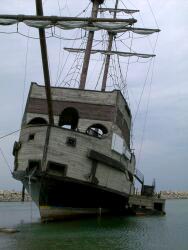
La Grande Hermine
par Ninj
Just off the western shore of Lake Ontario, between the cities of Hamilton and St. Catharines, there rests a nautical enigma. The little-understood landmark is a large wooden sailing ship, which lists strongly to one side as it half-rests, half-floats only a few metres off the shore in a small artificial cove. From up close, one can see that the vessel was once a floating restaurant called La Grande Hermine (The Big Weasel), after the ship Jacques Cartier used to sail up the St. Lawrence in 1535.
Scumbone, Liz and I wanted to know the boat´s whole story, and, in the absence of a nearby tourist info booth, souvenir shop or explanatory plaque, we were left with no choice but to hop aboard and get to the bottom of things.
We headed to the Hermine´s cove equipped with a pre-inflated Explorer 100 raft with a carrying capacity of 120 pounds. None of us weighed a mere 120 pounds, of course, but the raft had only cost $18 and I figured it would stay more-or-less afloat long enough to get us aboard. My companions were less sure of this, so I was given the honour of making the first journey.
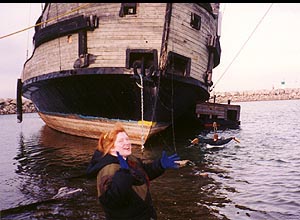 |
| Scumbone estimates the size of Ninj's stupidity. |
Armed with a flashlight, a camera, a rope and a couple of small boards to be used in place of oars, I lowered myself into the raft and headed out to sea. The raft clearly wasn´t happy about supporting my weight, and it took in a little more frigid December water with each stroke I made, until my jeans and socks were so wet as to be worse than useless. Ten metres seemed like a surprisingly long journey while I was paddling against the wind with half-frozen hands, but eventually I docked, climbed aboard and tied the raft to the Hermine. Scumbone and Liz were clearly not going to trust their fates to the Explorer 100, so I made a quick scouting and photo-taking trip around the ship to make sure it was worth the money and effort to come back later in the day with a better raft. It was.
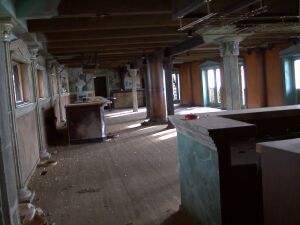
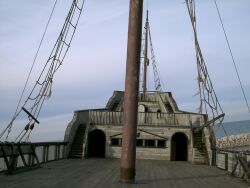
The Hermine ballroom and upper deck by daylight.
After I returned to the shore, the three of us headed off into town to warm up, eat, and purchase the supplies we´d need for our second attempt. At Canadian Tire, we were assisted by a young fellow named Eric, who seemed intently curious about our mission once he ascertained that we intended to go out to sea in an inflatable raft. Thankfully, he put his concern for our safety aside long enough to hook us up with some more rope, a large $50 raft that went by the name Windsurfer, and a foot-operated air-pump. When he told us for the third time that it was really too cold to go rafting in the middle of December, I tried to put his mind at ease by purchasing some HotPads.
We headed back to the cove, where we took shifts pumping up the new raft as the sky grew dark.
By the time we were done, the sun had set and it was extremely cold. It was decided that I would use my greater boating experience to help my companions across, so I first ferried across Liz, then paddled back to pick up Scumbone. Liz then used the rope to tug the two of us back to the Hermine, where we docked the Windsurfer and turned on our flashlights to have a look around.
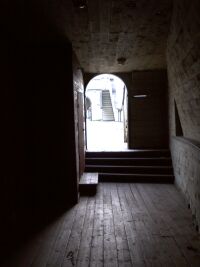 |
| The indoor portion of the main deck. |
The experience of exploring an unlit, long-abandoned, strongly-tilting, partially-flooded, pirate-ship-turned-restaurant is eerie and wonderful. We started on the lower deck, where we headed to the stern and found a small metal cage that we decided was the brig. I had Scumbone and Liz climb inside for a picture (naturally I thought about locking them in and leaving them there to die as a joke, but I needed a ride home).
As mentioned, the ship lists very strongly to one side. At first this makes walking, and particularly climbing stairs, quite difficult. After spending half an hour aboard the boat, though, you start naturally compensating for the angle until you pretty much forget about it. Of course, this makes for a very odd sensation when you peer out a window expecting to see the horizon and instead see nothing but an expanse of dark water.
Virtually the entire ship is constructed of wood, so the indoor areas have a wonderful cottage-y smell. It was also quite warm whenever we were inside. It would be great to go back sometime with sleeping bags and have a sleepover party — there are even a couple of leftover mattresses lying around in the hallway, near two sets of washrooms that have been helpfully designated as out of order.
Areas that were once living quarters are located near the stern on decks two and three; these are very small, but in a way that I´d describe as cozy rather than cramped. The quarters each have their own washrooms. The quarters on deck three also have their own little sundeck, where unfortunately the handrails have been mostly demolished, making for a creepy view.
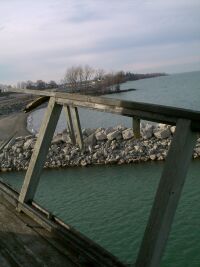
The view from the sundeck outside the crew quarters.
After wandering to the top of the ship on the outside decks, we descended back to deck one and re-entered the indoor part of the ship through a shattered glass door. We found ourselves in the large main dining hall, which was actually quite easy on the eye. The walls are painted with tasteful murals of naked ladies touching each other´s boobies, the wooden support pillars are nicely ornamentalized, and the shattered glass strewn across the floor catches the light in a pleasing way. Though beer bottles, melted candles and names and dates scrawled in the dust made it clear that the boat had been visited several times in the past, a few shattered mirrors and windows were about the worst vandalism we saw. Happily, no one has found it necessary to ruin the place with spraypaint or light it on fire.
After a quick peek into some storage rooms behind the bar, we proceeded into the kitchen. Though the Hermine was once a restaurant, there is no longer any food aboard, which is probably a good thing. There were also no seafaring rodents, birds or even insects aboard, as far as I could see. The only real remnants of the restaurant are large appliances like ovens and freezers, and a rather large dumb waiter that once shuttled food between the main kitchen on the lower deck and a smaller kitchen on the upper deck. We also noted an old metal mail drop here, marked “lettres’ and “enveloppes’: only then did it occur to Liz that every sign aboard the ship was in French. Like good Canadians, we´d automatically translated toilettes, hommes, dames, sortie and the like into English without noticing.
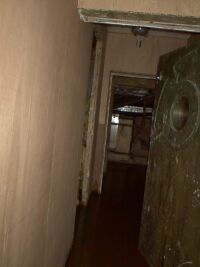
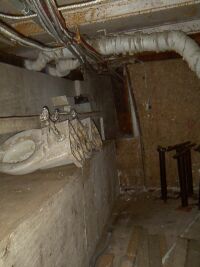
Much of the lower deck is flooded, one exception is the toilette bowl storage closet.
The last area we investigated was the completely unlit lower deck. The starboard side of the ship is entirely flooded with deep pools of black water, which prevented us from walking down some hallways, as we didn´t feel like sailing back to get another raft at this point. We did, however, get a good look at the furnace room, a mechanical/electrical room, four more toilette rooms and a special storage closet used exclusively for storing extra toilette bowls. (I think the former owner of the Hermine may have had a bit of a toilette fixation, to be honest.)
And so, after a very successful and satisfying expedition, we found the sortie and returned to civilization. 
This article originally appeared in Infiltration 15. Since then, a major fire in 2002 all but destroyed the ship, leaving only its rusting metal shell listing in the harbour. Hopefully whoever set fire to the ship is currently writhing in pain somewhere.
|

